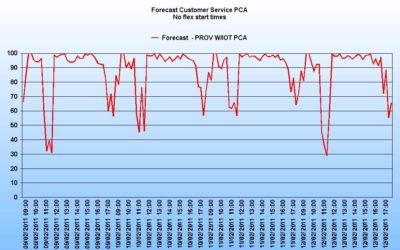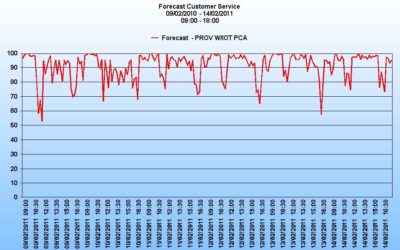Have you ever called customer service for a utility company or tried to place an order with a retailer only to suffer through their incredible wait times? How long are your customers willing to be placed on hold before abandoning the call? Abandoned calls are a universal problem for contact centers that can significantly impact a company’s bottom line. Companies that do not have a powerful and flexible workforce management scheduling tool that can accommodate creative scheduling are at risk for higher numbers of abandoned calls.
One solution to help reduce abandoned calls is the use of flexible start times. Custom tools called directives are available that allow flexible workforce management scheduling without changing all staff rules without the ability to roll back. Agents are allowed to enter preferences or schedule bids through an online tool that eliminates the need for administrative data entry. The result is variable start and end times, variable breaks and lunches, and a variable number of attendances week-to-week that are based on PTO requests, etc.
Inflexible scheduling can result in:
- Customers being inconvenienced
- Agents being stressed
- Extravagant operating costs to the organization
Benefits of introducing flexible schedules include:
- Savings that are passed on to the customer
- Increased satisfaction for agents, management, customers, and stakeholders
- Improved agent retention with schedules that work around the agent’s life instead of the agent’s life working around schedules
There are barriers to flexible workforce management scheduling, including use of scheduling tools incapable of formulating flexible schedules, State or Federal laws, having time for staff to manage the process, trying to be fair to everyone by treating them consistently, and the fact that some agents prefer the same start time each day with set breaks and lunches.
Pipkins demonstrates the impact of introducing flexibility to start times. A group of 96 staff were chosen to be scheduled, comprised of 64 full-time and 32 part-time employees in six teams of 16 each. Initially, all members of a team were scheduled to start at the same time everyday. Some limited flexibility would then be introduced to assess the impact of relatively small changes in flexible workforce management scheduling.
Fixed Start Times
The first schedule was produced using Pipkins’ Team Based Scheduling (TBS) feature to produce schedules where the start times of all members in each team were fixed for the whole week.
When the expected Percentage of Calls Answered (PCA) was calculated based on the schedules, it showed periods where service dropped noticeably:

The overall achieved PCA for the week was 86.2%
Flexible start times
3.1 Flexibility of 1 hour within the team but no flexibility day to day
In a test of flexible workforce management scheduling, a change was first introduced where individual team members had to start within one hour of any other team member for the week. However, each individual’s start time was consistent day-to-day. The resulting PCA is shown below:

In this case, the troughs in achieved PCA were significantly less, giving a more consistent quality of service over the week. The weekly PCA rose to 89.6%
3.2 Flexibility of 1 hour within the team and 1 hour day to day
The final example shows the effect of allowing not only one-hour flexibility within the team, but also the same flexibility for each agent day-to-day. The expected PCA is
below:

There is further reduction in the number and depth of the troughs and the PCA rose again to 92.6% for the week.
Conclusion
Using the same number of agents, this exercise demonstrates how the introduction of flexible workforce management scheduling can have a marked impact on accurately meeting the requirements, and consequently on the service, offered to the customer both in absolute terms – a 6.4% increase in the PCA – but also in consistency – the PCA only dropping below 70% for one interval on one day. A little flexibility can make a big impact.
About Pipkins
Pipkins, Inc. is a leading supplier of workforce management software and services to the call center industry. Vantage Point, Pipkins’ premier product, is the most accurate forecasting and scheduling tool on the market. Pipkins’ @HomeVantage gives organizations the ability to effectively manage their agents and can be used with Vantage Point or integrated into another workforce management system to leverage existing technology. Pipkins’ systems forecast and schedule more than 300,000 agents in over 500 locations across all industries worldwide.
